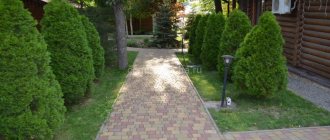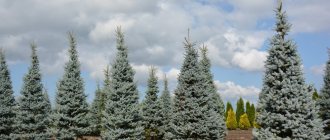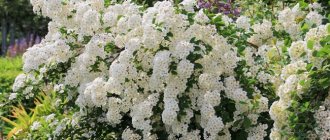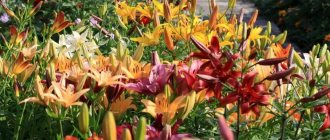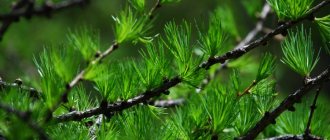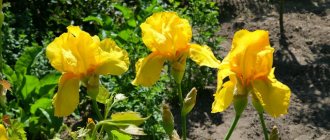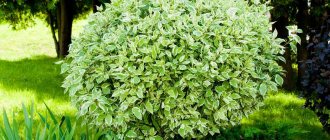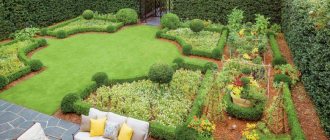Thujas can give any garden plot an attractive and elegant appearance. They are planted solo, in groups, along alleys, in rock gardens, mixboards, and on alpine hills. There is a huge variety of types and varieties of thuja. Therefore, they will harmoniously fit into absolutely any landscape design and become its main decoration.
In this article we will look at the advantages and disadvantages of planting conifers on the site, what types and varieties of thuja exist, how to plant and care for them correctly, and much other useful information.
Guest from America
It is believed that the green beauty came to Europe from the North American continent. In its homeland, this plant can live for one and a half hundred years.
In the wild, its diameter reaches six meters and its height reaches seventy. Our maximum specimens grow up to eleven meters in height.
Photos of thuja can always be found on gardeners’ blogs as a source of special pride.
HISTORY OF TUARY DISTRIBUTION
The homeland of thuja is considered to be North America and East Asia. Plants from these two continental parts are very different from each other and therefore they were divided into two main types - thuja occidentalis and thuja eastern.
For gardeners, the greatest interest is the thuja occidentalis or the “tree of life”, as it is also called. Thuja occidentalis was brought to Europe from the northeastern regions of North America in the middle of the 15th century.
In Russia, it began to be actively used in the design of palace parks and landscaping of large cities from the end of the 16th century.
Unlike the eastern thuja, the western one is more compact and does not exceed 3.5 m in height. The most beautiful are the thujas with a golden crown.
Today, the most fashionable variety of such thuja is considered Yantar , which in the last three years has repeatedly become the winner of International and All-Russian competitions and exhibitions.
How to plant
If you have experience planting trees, success is almost guaranteed. Since it is recommended to plant thuja using conventional technology.
The depth and width of the hole depends on the size of the seedling, which is usually taken along with a lump of soil.
Dig a hole with a depth of 25-30 cm and a width of 30-40 cm. Add earth mixed with a small amount of humus to the bottom.
Moisten the roots well. Place the seedling strictly in the middle of the hole. Gently straighten the roots and bury them.
We recommend reading:
Flowers for a flower bed blooming all summer until autumn: photo and nameFern and its types: characteristics, features and propagation tips
Autumn flowers in the garden: photos and names
The root collar should be located above ground level. Compact the hole and water thoroughly.
When all the water has been absorbed into the ground, mulch the tree trunk area. To do this, you can take wood chips, pine cones, shavings. This will help retain moisture in the soil and protect the roots in heat or frost.
Types and varieties of coniferous plants
There are two types of thuja, which in turn are divided into numerous varieties:
- Western.
- Eastern.
The most popular varieties of the Western species are:
- Danniku . A low tree up to half a meter in height and up to 1 m in diameter. Completely easy to care for. Grows on suspended and light loamy soils. Planted as a single plant, it looks beautiful among flowers. It grows slowly, therefore, the overall composition of the flower garden does not change its appearance for a long time. Thuja looks especially attractive near the house;
- Globos . Its height is about 1 m. It grows on fertile soils and likes moderate watering. Fits harmoniously into any landscape designs;
- Hoseri . A small tree, 40 cm in diameter. Well suited for small areas, planted in stone gardens and rock gardens.
Among the oriental species, the following varieties are worth highlighting:
- Justinka . Its height reaches 1 m, the crown is columnar, bright green. Looks good in small compositions;
- Columna . Externally similar to cypress. The height reaches 8 m, and in diameter it spreads over 1 m. Suitable for creating a Mediterranean style in the country;
- Wagnery . A tall tree, the height of which reaches 4 m. It tolerates frost well, but does not like snowfall. Its branches break off under the weight of the snow. It is recommended to plant in open areas.
Watering
The plant loves moisture and all types of thuja respond well to watering. In the first days after planting, you need to water weekly, from one to five buckets per specimen.
Sprinkling also has a beneficial effect on the development of seedlings. The soil is filled with moisture, dust and dirt are removed from the needles, which promotes better breathing of the plant.
You should loosen the hole carefully. Its roots are located superficially, therefore, you need to go deep no more than 10 cm.
Nuances of culture and dignity
Thuja is an evergreen coniferous plant. Ideal growing conditions are a temperate climate zone with the absence of high and low temperatures. Thuja is a universal option for planting, taking into account varietal characteristics and following the rules of care.
As mentioned above, thuja has a wide variety of species - from a small shrub to a two-meter tree.
If you take these features into account, you can use plants either as a separate decoration, or in combination with other crops, or plant them separately.
There are western and eastern types of conifers. Western is more popular.
Western varieties
Dannika
. It is a small shrub up to 50 cm, capable of growing up to a meter in height and width.
Advantages of the variety:
- easy care;
- unpretentious;
- can grow in sandy loam and light loamy soil;
- goes well with a flower garden, used as part of a composition, and also as a separate shrub;
- long-term preservation of an ideal appearance, since the ephedra grows at a very slow pace.
The disadvantages of the variety are susceptibility to lack or excess of water.
Globosa
- This is a varietal subspecies with a crown diameter of 1 meter.
Advantages:
- a universal option for decorating a site;
- grown in moderately moist soil.
Flaws:
- adult individuals lose their shape;
- if there is excess moisture, the plant will not be able to grow and develop normally.
Hoseri
. The plant is small in size, grows up to 40 cm.
Advantages - a universal decorative solution for any type of site due to its small dimensions.
Cons: Requires only moderately moist, nutrient-rich soil.
Emerald.
The variety is characterized by high growth - 3-5 meters and a width of 2 meters.
Advantages:
- Thuja has a rich color of needles;
- a tree lives up to 150 years;
- The variety is resistant to light frosts;
- also grows in shaded areas;
- unpretentious in the choice of soil, but limestone would be the best option.
Disadvantages - the lower branches lose color saturation in the event of a long absence of sunlight.
Oriental varieties
Aurea nana
- a type of thuja that grows up to 80 cm.
Pros:
- the crown shape is oval;
- has a beautiful golden color;
- growth occurs vertically.
Minuses:
- needs protection from wind and cold.
Justinka.
The height of the thuja is 1 meter.
Advantages:
- plant shape - column;
- the needles have a rich green color;
- It looks great both as a separate decorative unit and in combination with several crops.
Cons: additional protection and shelter from frost is required.
Transfer
If you need to transplant a thuja, especially when you need to transplant a grown specimen to another place, pierce the soil around the trunk at a distance of about half a meter.
Then pry the root system with a shovel (it is advisable to use three shovels on three sides at the same time with helpers) and pull out the root along with the lump of soil.
Without destroying the lump, move the tree to a new place and lower it into a hole dug in advance. Sprinkle with soil, compact and water.
The nuances of the compatibility of thuja with other crops in a summer cottage
To create a beautiful landscape with thujas, you should know what they combine harmoniously with. These plants are planted one at a time in cases where we are talking about a tall specimen. And small trees should be placed on the site in small groups.
When planting thujas next to other plants, attention is paid to ensuring that both the first and second ones have the right soil composition. Along with them, low-growing mountain pines feel good in partial shade. And in a sunny meadow, black pines can become their companions.
You can also plant the following plants and shrubs next to the thujas:
- spirea;
- barberry;
- hybrid weigela;
- roses;
- magnolia;
- Potentilla
Attention: thujas do not like proximity to larch.
These plants look beautiful near children's playgrounds. Unlike their relatives, Christmas trees, they are completely safe for children, since their needles are soft. In addition, they release phytoncides that purify the air.
Reproduction
Thuja also reproduces by seeds, but this process takes a long time. Therefore, most gardeners prefer this method as cuttings.
Planting material for this is prepared in June. From a well-developed skeletal branch, break off a 2-3 year old woody growth so that a “heel” remains at its end.
The cutting length is usually 10-15 cm. The harvested material is kept in a growth regulator for 12 hours. Then they are planted in suitable containers filled with a soil mixture consisting of sand, earth and peat taken in equal proportions.
New shoots that appear on the branches indicate that the planting material has taken root. In late autumn, the seedlings are covered with spruce branches or fallen leaves and left into the winter.
In the spring, thuja seedlings can be planted in a permanent place, but it is better to wait a year or two until they gain strength. Options for the original placement of plants on the site and photos of planting thujas in different compositions can be found on the Internet.
Description and characteristics
The genus of perennial conifers is represented mainly by shrubs, less often by trees. The latter can reach a height of 70 meters in nature, while the crown diameter does not exceed 6 m. Representatives of the Cypress family at the beginning of development have soft, needle-like foliage. The latter becomes scaly over time. The location of the needles on the branches is supratative.
The widespread use of ephedra in landscaping explains the variety of crown shapes. There are five types:
- Pyramidal. Conifers with this crown shape grow up to 2-3 m. Suitable for group planting or as a tapeworm.
- Columnar. The crown shape can be of both tall and short growing varieties. Instances are often used to frame alleys or garden paths.
- Umbrella-shaped. The type of crown is typical for medium-sized conifers with which ridges are decorated.
- Pin-shaped. The shape is similar to a pyramidal one, but more rounded and dense. Due to their excellent tolerance to pruning, plants are planted as future art objects.
- Globular. The type unites a group of low-growing varieties with slow growth rates. The latter allow you to maintain this crown shape throughout the entire life cycle.
For your information!
Dwarf arborvitae combine well with small fountains, ledges and ponds, allowing them to be used in various parts of the garden.
Wintering
Trees that are less than five years old need to be covered with spruce branches. Place a thick mulch around the trunk - peat, pine cones or pine needles.
If there is a lot of snow in winter, the branches may break under the heavy weight. To prevent the unpleasant consequences of snowfalls, experienced gardeners secure the crown with a rope in the fall.
In the last days of February, it is advisable to throw a light material over the plant, which will protect the green branches from direct sunlight.
Sometimes the bark undergoes cracking as a result of large temperature changes between night and day. With the first thaw, such cracks need to be covered with garden varnish.
Ideas for using thujas in the landscape design of a summer cottage
Thuja is an ornamental plant and does not perform any other functions. Therefore, they are planted only to create a beautiful landscape. Since it can be a tall tree or spreading shrub, conifers are planted on the site depending on the variety. Some species look beautiful as hedges, others are planted only solo or in groups. Dwarf rocks are ideal for rockeries, mixboards and rock gardens.
Attention : with the help of thujas, various decorative elements are beautifully complemented on the site.
Small thujas look great in pots and flowerpots. And the average ones love to be among brightly blooming flowers. In addition, they can be used to decorate: alleys, terraces, balconies and loggias. Particular attention should be paid to thuja figures. Experienced gardeners make them real works of art in the country.
Attention: if you use different varieties of thuja in the landscape, this will help create an interesting and original composition.
In a large area, you can create an entire alley of conifers, in the center of which a fence made of tall varieties of conifers will fit beautifully. Low trees with bright green needles are planted in the flower beds. Bright flowers in the shape of a ball are selected for them.
As you can see, this ornamental plant fits harmoniously into any landscape, emphasizing the status of its owners and their impeccable taste, as well as the elegance and nobility of the entire suburban area.
Diseases and pests
The cause of the lesions is most often the fungi Fusarium, Foma and others. An effective remedy for tree restoration is cardocide and Bordeaux mixture.
Treatment is done with the beginning of the spring thaw with an interval of fifteen days until complete recovery.
If the thuja has turned yellow, look for pests. Among the harmful insects, thuja aphids and false scale insects should be distinguished. As a result of their invasion, the needles turn yellow and begin to fall off.
Measures to combat these pests are spraying with rogor or karbofos two to three times a month.
Advantages and disadvantages
May be interesting Garden equipment from MTD: what they produce, reviews from ownersWhere you can inexpensively order rolls in TyumenAgricultural spare parts: where to order and what to pay attention to
The evergreen plant is widely used not only by landscape designers, but also by owners of dachas and country houses, trying to create an atmosphere of harmony and comfort and unity with nature on the site. Due to the variety of forms, which is identified as the main advantage, conifers are used to decorate alpine hills (compact, low-growing varieties are suitable), to form hedges (specimens with fast growth rates are planted).
Thuja, like any coniferous plant, releases phytoncides, creating a special microclimate in the yard. The culture has soft needles. Thanks to this characteristic, it can be placed near children's playgrounds and in recreation areas. Since the shoots are not prickly, like those of pine or spruce, children will not be able to injure themselves on them during active games. Among the disadvantages of thuja when used in design is its superficial root system, due to which the plant cannot be grown in lowlands. It does not develop well in waterlogged soils. In addition, in Siberia and the Urals, thujas need shelter. Shoots damaged by frost turn black and dry out, spoiling the decorative appearance of not only the conifer itself, but also the entire landscape composition.
Thuja occidentalis Smaragd
The tree of this variety has a narrow columnar crown reaching a height of several meters. The crown of this thuja variety is made up of short fan-shaped branches, closely pressed to one another.
Slow growing plant with average frost resistance. Easily withstands frosts up to 25 degrees. It has a number of advantages over other varieties: it does not become bare from below, and has a rich green color of needles throughout the year.
